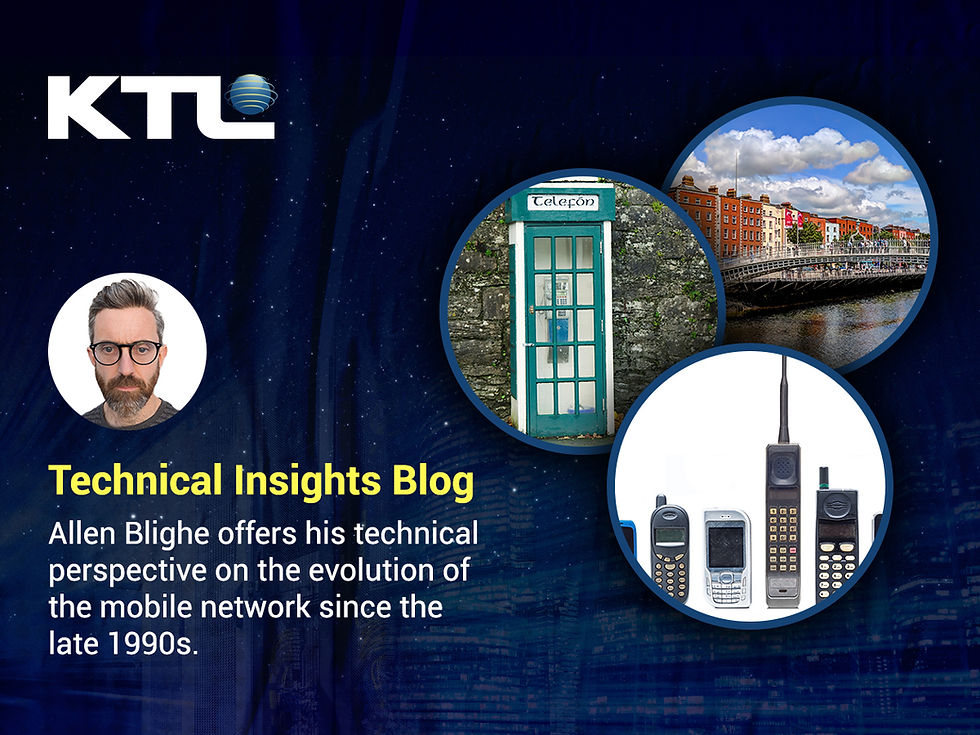Dominic Mackinnon, Technical Manager KTL shares his insights on OpenRAN
- KTL
- Nov 27, 2023
- 3 min read
Can you provide a brief introduction of yourself and your expertise in the field?
I’ve been working with Vodafone on OpenRAN for the past three years. We have helped to design, build and commission some of the first commercial sites now live in Southern England.
What is OpenRAN?
First, it is good to understand traditional RAN. Simply put, a typical cell site consists of three main components, all connected using coaxial, fibre and power cables:
Antennas – these convert electrical signals into radio waves.
Radio units – these transform digital information into signals that are sent wirelessly.
Controllers – these provide a set of signals processing functions, typically using custom electronics combined with software to enable wireless communications. The controller connects base stations to the MNO’s core network.
Three RAN companies currently cover 70% of the worldwide market (Ericsson, Huawei, and Nokia). This means that they effectively control the market.
OpenRAN is a disruptor and disaggregates these components, which is allowing different suppliers to enter the market from both a hardware and software perspective.
The ORAN Alliance ensures Standards-based compliance, allows all suppliers to test solutions against those standards in an open and neutral environment.
Interoperability is needed, ensuring the disaggregated elements work together as a system.
Suppliers are encouraged to innovate and differentiate on their product features to improve performance and features.
How does OpenRAN work? What is new, revolutionary about it?
The principles are the same as with a traditional vendor RAN network, in the sense that the same physical elements are needed to function.
The key differentiator is the single vendor is now made up of many smaller suppliers, removing the non-proprietary restrictions imposed by large vendor products.
How does OpenRAN fit within the broader technology landscape?
In April 2022, the UK government1 announced a joint ambition with the UK Mobile Network Operators for 35% of mobile network traffic to pass through OpenRAN by 2030.
It was also agreed by the U.K. mobile network operators2 that 2033 will be the date by which all public 2G and 3G networks in the country will be switched off.
The purpose of this initiative is to free up spectrum for the mass deployment of 5G and other future networks facilitating driverless vehicles and drones, immersive VR and AR experiences, and innovations around sustainability and healthcare.
ORAN will play a big part as many operators worldwide in other countries have now committed to delivering commercial ORAN in their networks with a focus on security and resilient telecoms supply chains.
Who is using OpenRAN?
The Current State of OpenRAN - Countries & Operators | TeckNexus 20213

Can you share any real-world examples of how OpenRAN is being used?
Vodafone UK4 is rolling out OpenRAN technology in south-west England. The roll out will ramp up following the successful trial of the “golden cluster”.
Deployments such as the “golden cluster” will help operators decide just how useful OpenRAN architectures can be as part of their mobile networking strategy.
What are the benefits or advantages?
Quicker deployment of software changes and features.
Fewer limitations resultant of software packages typically rolled out periodically by the large vendors, support is not always guaranteed.
Lower costs – which might not be realised immediately but over time are anticipated.
Are there any common misconceptions or myths surrounding OpenRAN?
There are concerns about it being truly a plug n’ play solution when mixing different supplier equipment and software.
ORAN alliance standards must be clearly followed and facilitated to avoid the need for further significant development between companies.
The ORAN Alliance5 points to the continuous nature of development via several working groups, and those elements in turn must be tested, implemented, and evaluated to fully understand if successful across the network architecture.
Are there any potential risks, challenges, or limitations with OpenRAN?
The EU published a report6 on the cybersecurity of OpenRAN, a 4G/5G network architecture. The EU noted that while OpenRAN architectures create new opportunities in the marketplace, they also raise important security challenges, especially in the short term.
As OpenRAN increases the complexity of networks, it might end up making certain security risks even more serious. It basically provides more ways for bad actors to attack since there are more entry points into the system. Additionally, there's a higher chance of misconfigurations in the network settings and sharing resources could potentially cause problems for other parts of the network.
The report added that technical specifications developed by the O-RAN Alliance, are not yet sufficiently secure by design. This means that OpenRAN could lead to new or increased critical dependencies, for example in components and cloud.

How do you envision the future?
There is a steady uptake in rural locations, confidence will rise from there from each MNO.
More ORAN will reduce overall costs, create greater competition between the large incumbent vendors, who will have to compete for business with smaller suppliers.
To find out more about KTL services go to: ktl.ie/services
Sources
















Comments